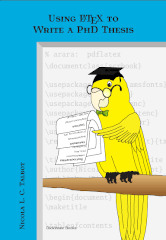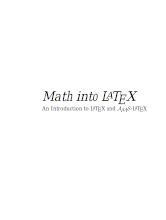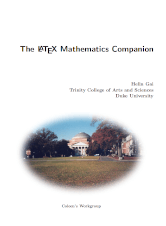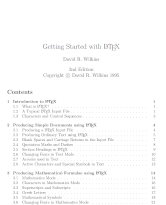Last Updated on August 17, 2024
9. Using LaTeX to Write a PhD Thesis by Nicola L. C. Talbot

Using LaTeX to Write a PhD Thesis is intended as a brief guide on how to typeset the various components that are usually required for a thesis
This book assumes you have a basic knowledge of LaTeX. It’s recommended that you read LaTeX for Complete Novices first. There’s a link to that book on the first page of this article.
There’s a paperback version of the book available.
The book covers the following areas:
- Introduction – covers how to build your document.
- Getting Started.
- Splitting a Large Document into Several Files.
- Formatting – change the document style, change the page style, double-spacing, change the title page, tabbing and more.
- Generating a Bibliography – JabRef, BibTeX, and Biblatex are explored.
- Generating Indexes and Glossaries – using an external indexing application, using LaTeX to sort and collate indexes or glossaries.
Permission is granted to copy, distribute and/or modify this document under the terms of the GNU Free Documentation License, Version 1.2 or any later version.
10. Math into LaTeX by George Grätzer
 Math into LaTeX: An Introduction to LaTeX and AMS-LaTeX is a 114 page book that’s targeted at the mathematician, engineer, scientist, or technical typist who wants to write and typeset articles containing mathematical formulae.
Math into LaTeX: An Introduction to LaTeX and AMS-LaTeX is a 114 page book that’s targeted at the mathematician, engineer, scientist, or technical typist who wants to write and typeset articles containing mathematical formulae.
The book starts with a short course in LaTeX, and then proceeds to introduce TeX, LaTeX, and AMS-LaTeX. Later chapters discuss BIBTeX and MakeIndex.
This book is not released under an open source license.
11. LaTeX Mathematics Companion by Helin Gai
 LaTeX Mathematics Companion assumes the reader already has some LaTeX experience.
LaTeX Mathematics Companion assumes the reader already has some LaTeX experience.
Chapters focus on the standard LaTeX commands and environments, how to customize math formula. There’s a chapter which gives an overview of over 30 packages. The book closes with further directions on useful LaTeX resources.
This book is not released under an open source license.
12. Getting Started with LaTeX by David R. Wilkins
 Getting Started with LaTeX is a short book (46 pages) that explains how to produce simple documents using LaTeX, produce mathematical formulae using LaTeX.
Getting Started with LaTeX is a short book (46 pages) that explains how to produce simple documents using LaTeX, produce mathematical formulae using LaTeX.
It also describes further features of LaTeX such as producing white space, generate lists, tables, and more.
This book is not released under an open source license.
Next page: Page 4 – The Computer Science of TeX and LaTeX and more books
Pages in this article:
Page 1 – LaTeX Tutorials: A Primer and more books
Page 2 – Let’s Learn LaTeX and more books
Page 3 – Using LaTeX to Write a PhD Thesis and more books
Page 4 – The Computer Science of TeX and LaTeX and more books
All books in this series:
| Free Programming Books | |
|---|---|
| Ada | ALGOL-like programming language, extended from Pascal and other languages |
| Agda | Dependently typed functional language based on intuitionistic Type Theory |
| Arduino | Inexpensive, flexible, open source microcontroller platform |
| Assembly | As close to writing machine code without writing in pure hexadecimal |
| Awk | Versatile language designed for pattern scanning and processing language |
| Bash | Shell and command language; popular both as a shell and a scripting language |
| BASIC | Beginner’s All-purpose Symbolic Instruction Code |
| C | General-purpose, procedural, portable, high-level language |
| C++ | General-purpose, portable, free-form, multi-paradigm language |
| C# | Combines the power and flexibility of C++ with the simplicity of Visual Basic |
| Clojure | Dialect of the Lisp programming language |
| ClojureScript | Compiler for Clojure that targets JavaScript |
| COBOL | Common Business-Oriented Language |
| CoffeeScript | Transcompiles into JavaScript inspired by Ruby, Python and Haskell |
| Coq | Dependently typed language similar to Agda, Idris, F* and others |
| Crystal | General-purpose, concurrent, multi-paradigm, object-oriented language |
| CSS | CSS (Cascading Style Sheets) specifies a web page’s appearance |
| D | General-purpose systems programming language with a C-like syntax |
| Dart | Client-optimized language for fast apps on multiple platforms |
| Dylan | Multi-paradigm language supporting functional and object-oriented coding |
| ECMAScript | Best known as the language embedded in web browsers |
| Eiffel | Object-oriented language designed by Bertrand Meyer |
| Elixir | Relatively new functional language running on the Erlang virtual machine |
| Erlang | General-purpose, concurrent, declarative, functional language |
| F# | Uses functional, imperative, and object-oriented programming methods |
| Factor | Dynamic stack-based programming language |
| Forth | Imperative stack-based programming language |
| Fortran | The first high-level language, using the first compiler |
| Go | Compiled, statically typed programming language |
| Groovy | Powerful, optionally typed and dynamic language |
| Haskell | Standardized, general-purpose, polymorphically, statically typed language |
| HTML | HyperText Markup Language |
| Icon | Wide variety of features for processing and presenting symbolic data |
| J | Array programming language based primarily on APL |
| Java | General-purpose, concurrent, class-based, object-oriented, high-level language |
| JavaScript | Interpreted, prototype-based, scripting language |
| Julia | High-level, high-performance language for technical computing |
| Kotlin | More modern version of Java |
| LabVIEW | Designed to enable domain experts to build power systems quickly |
| LaTeX | Professional document preparation system and document markup language |
| Lisp | Unique features - excellent to study programming constructs |
| Logo | Dialect of Lisp that features interactivity, modularity, extensibility |
| Lua | Designed as an embeddable scripting language |
| Markdown | Plain text formatting syntax designed to be easy-to-read and easy-to-write |
| Objective-C | Object-oriented language that adds Smalltalk-style messaging to C |
| OCaml | The main implementation of the Caml language |
| Pascal | Imperative and procedural language designed in the late 1960s |
| Perl | High-level, general-purpose, interpreted, scripting, dynamic language |
| PHP | PHP has been at the helm of the web for many years |
| PostScript | Interpreted, stack-based and Turing complete language |
| Prolog | A general purpose, declarative, logic programming language |
| PureScript | Small strongly, statically typed language compiling to JavaScript |
| Python | General-purpose, structured, powerful language |
| QML | Hierarchical declarative language for user interface layout - JSON-like syntax |
| R | De facto standard among statisticians and data analysts |
| Racket | General-purpose, object-oriented, multi-paradigm, functional language |
| Raku | Member of the Perl family of programming languages |
| Ruby | General purpose, scripting, structured, flexible, fully object-oriented language |
| Rust | Ideal for systems, embedded, and other performance critical code |
| Scala | Modern, object-functional, multi-paradigm, Java-based language |
| Scheme | A general-purpose, functional language descended from Lisp and Algol |
| Scratch | Visual programming language designed for 8-16 year-old children |
| SQL | Access and manipulate data held in a relational database management system |
| Standard ML | General-purpose functional language characterized as "Lisp with types" |
| Swift | Powerful and intuitive general-purpose programming language |
| Tcl | Dynamic language based on concepts of Lisp, C, and Unix shells |
| TeX | Markup and programming language - create professional quality typeset text |
| TypeScript | Strict syntactical superset of JavaScript adding optional static typing |
| Vala | Object-oriented language, syntactically similar to C# |
| VHDL | Hardware description language used in electronic design automation |
| VimL | Powerful scripting language of the Vim editor |
| XML | Rules for defining semantic tags describing structure ad meaning |
